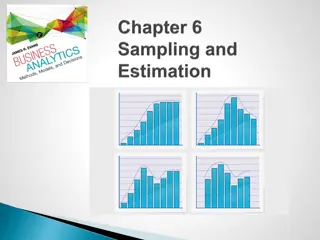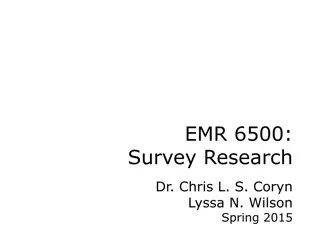Understanding Accounting Research Methods: Measurement and Sampling
Measurement is a crucial aspect of research in accounting. It involves assigning numbers to empirical events, objects, or properties. Measurement consists of selecting measurable phenomena, developing mapping rules, and applying these rules appropriately. The process of measurement includes determining measurement scales and understanding different types of scales such as nominal, ordinal, interval, and ratio. Levels of measurement classification further elaborate on the characteristics of scales. Evaluating measurement tools involves assessing validity, reliability, and practicality to ensure accurate and meaningful results.
Download Presentation

Please find below an Image/Link to download the presentation.
The content on the website is provided AS IS for your information and personal use only. It may not be sold, licensed, or shared on other websites without obtaining consent from the author. Download presentation by click this link. If you encounter any issues during the download, it is possible that the publisher has removed the file from their server.
E N D
Presentation Transcript
Metode Riset Akuntansi Measurement and Sampling
Measurement Measurement in research consists of assigning numbers to empirical events, objects, or properties, or activities in compliance with a set of rules
Measurement Selecting measurable phenomena Developing a set of mapping rules Applying the mapping rule to each phenomenon
Measurement Scales Several types of measurement are possible Depends on what you assume about mapping rule Mapping rules have four characteristics: Classification Order Distance Origin
Types of Scales Nominal Ordinal Interval Ratio
Levels of Measurement Classification Nominal Ordinal Interval Ratio
Levels of Measurement Classification Nominal Classification Ordinal Order Interval Ratio
Levels of Measurement Classification Nominal Classification Ordinal Order Classification Distance Interval Order Ratio
Levels of Measurement Classification Nominal Classification Ordinal Order Classification Distance Interval Order Classification Distance Natural Origin Ratio Order
Sources of Error Respondent Situation Measurer Instrument
Evaluating Measurement Tools Validity Criteria Reliability Practicality
Evaluating Measurement Tools Validity is the extent to which a test measures what we actually wish to measure Reliability has to do with the accuracy and precision of a measurement procedure Practicality is concerned with a wide range of factors of economy, convenience, and interpretability
Validity Two major forms: External validity: data s ability to be generalized Internal validity: the ability of a research instrument to measure what it is purported to measure
Validity Determinants Content Criterion Construct
Content Validity The extent to which it provides adequate coverage of the investigative questions guiding the study
Increasing Content Validity Literature Search Group Interviews Content Expert Interviews
Validity Determinants Content Construct
Construct Validity Consider both theory and the measuring instrument being used
Validity Determinants Content Criterion Construct
Criterion-Related Validity Reflects the success of measures used for prediction or estimation
Understanding Validity and Reliability
Reliability Estimates Stability Internal Consistency Equivalence
Practicality Economy Convenience Interpretability
Methods of Scaling Rating scales Have several response categories and are used to elicit responses with regard to the object, event, or person studied. Ranking scales Make comparisons between or among objects, events, persons and elicit the preferred choices and ranking among them.
Simple Category/Dichotomous Scale I plan to purchase a MindWriter laptop in the 12 months. Yes No Nominal Data
Multiple-Choice, Single Response Scale What newspaper do you read most often for financial news? East City Gazette West City Tribune Regional newspaper National newspaper Other (specify:_____________) Nominal Data
Multiple-Choice, Multiple Response Scale What sources did you use when designing your new home? Please check all that apply. Online planning services Magazines Independent contractor/builder Designer Architect Other (specify:_____________) Nominal Data
Likert Scale The Internet is superior to traditional libraries for comprehensive searches. Strongly disagree Disagree Neither agree nor disagree Agree Strongly agree Interval Data
Semantic Differential Interval Data
Numerical Scale Ordinal or Interval Data
Multiple Rating List Scales Interval Data
Stapel Scales Interval Data
Constant-Sum Scales Interval Data
Graphic Rating Scales Interval Data
Ranking Scales Paired-comparison scale Forced ranking scale Comparative scale
Paired-Comparison Scale Ordinal Data
Forced Ranking Scale Ordinal Data
Comparative Scale Ordinal or Interval Data
The Nature of Sampling The basic idea of sampling is that by selecting some of the elements in a population, we may draw conclusions about the entire population
The Nature of Sampling Population element: the individual participant or object on which the measurement is taken Population: total collection of elements about which we wish to make some inferences Census: a count of all the elements in a population Sample frame: listing of all population elements from which the sample will be drawn
Why Sample? Availability of elements Lower cost Sampling provides Greater speed Greater accuracy
What Is A Good Sample? Accuracy Precision
Accuracy Accuracy is the degree to which bias is absent from the sample Systematic variance Increasing the sample size
Precision A measure of how closely the sample represents the population Measured by the standard error of estimate
Sampling Designs Probability sampling Elements in the population have some known chance or probability of being selected as sample subjects Nonprobability sampling Elements do not have known or predetermined chance of being selected as subjects
Types of Sampling Designs Element Selection Unrestricted Probability Nonprobability Simple random Convenience Restricted Complex random Purposive Systematic Judgment Cluster Quota Stratified Snowball Double
Simple Random Purest form of probability sampling
Simple Random Advantages Easy to implement Disadvantages Requires list of population elements Time consuming Can require larger sample sizes
Systematic Every kth element in the population is sampled, beginning with a random start of an element in the range of 1 to k
Systematic Advantages Simple to design Easier than simple random Disadvantages Periodicity within population may skew sample and results Trends in list may bias results























